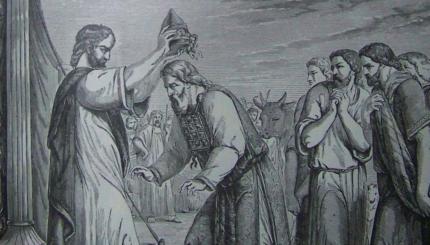Excerpted with permission from Saying Kaddish: How to Comfort the Dying, Bury the Dead, & Mourn as a Jew (Schocken Books).
The traditional clothing for burying the dead are tachrichim, simple white shrouds. Their use dates back to Rabbi Simeon ben Gamliel II, who, in the second century of the Common Era, asked to be buried in inexpensive linen garments. The custom — which set both a decorous minimum and a limit on ostentation — has been followed by observant Jews ever since: “Whoever heaps elaborate shrouds upon the dead transgresses the injunction against wanton destruction. Such a one disgraces the deceased.”
The universal use of shrouds protected the poor from embarrassment at not being able to afford lavish burial clothes. Since shrouds have no pockets, wealth or status cannot be expressed or acknowledged in death. In every generation, these garments reaffirmed a fundamental belief in human equality.
Shrouds are white and entirely hand-stitched. They are made without buttons, zippers, or fasteners. Tachrichim come in muslin or linen, fabrics that recall the garments of the ancient Hebrew priesthood. There is little difference in appearance or cost between them; the funeral home may or may not offer a choice.
With your help, My Jewish Learning can provide endless opportunities for learning, connection and discovery.
Tachrichim come packaged in sets for men and women. Regardless of gender, they include shirt, pants, a head covering, and a belt. Men may also be wrapped in a kittel, a simple, white ceremonial jacket that some Jews wear on Yom Kippur, at the Passover seder, and under the wedding canopy.
If the body has been prepared for burial with tahara [ritual purification], the body will automatically be dressed in tachrichim. Jewish funeral homes and hevra kaddishas [sacred burial societies] have a supply on hand, and the cost may be covered by their honorarium. If you are in an area where there is no Jewish funeral home or burial society, the local mortuary may permit you to prepare the body according to Jewish law. A Jewish funeral home in the nearest city can send a set of shrouds by overnight mail.
In addition to tachrichim, some Jews are wrapped in the prayer shawl, or tallit, in which they prayed. Every tallitis tied with four sets of knotted fringes (tzitzit), which symbolize mitzvot, the commandments incumbent upon Jews. Before the tallit is placed on a body for burial, however, one of the sets of fringes is cut to demonstrate that the person is no longer bound by the religious obligations of the living.
When only men wore tallitot, only men were buried in them. But any woman who wore a prayer shawl in life–an increasingly common custom–is generally accorded the same treatment. This may be an issue if the hevra kaddisha is comprised of Orthodox Jews who object to women’s use of tallitot; mourners should be clear about their wishes.
Tachrichim swaddle the entire body, including the face, so that the deceased is both clothed and protected against the gaze of other people. If shrouds are used, the body is placed in the casket, which is then closed.
A small bag of earth from Israel may be placed in the coffin–another reminder of the biblical phrase, “For you are dust, and to dust shall you return” and a sign of the importance of the land of Israel to Jews throughout the centuries. (Jewish funeral homes generally offer this option.) Notes or other personal mementos are sometimes placed in the casket as well.
Some people express a wish to be buried in a particular dress or suit and some mourners are uncomfortable with the idea of shrouds for a family member who abhorred all religious tradition and trappings. Liberal Jews sometimes honor the tradition of simplicity by requesting a minimum of handling, no cosmetics on the body, and a closed casket.
Sign up for a Journey Through Grief & Mourning: Whether you have lost a loved one recently or just want to learn the basics of Jewish mourning rituals, this 8-part email series will guide you through everything you need to know and help you feel supported and comforted at a difficult time.
Looking for a way to say Mourner’s Kaddish in a minyan? My Jewish Learning’s daily online minyan gives mourners and others an opportunity to say Kaddish in community and learn from leading rabbis.
tallit
Pronounced: tah-LEET or TAH-liss, Origin: Hebrew, prayer shawl.


